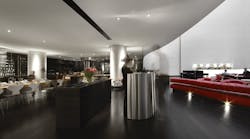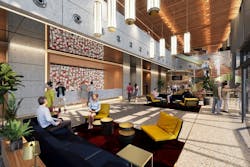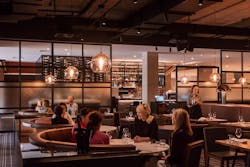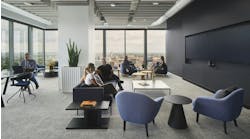Pristine beaches, mountain-high retreats and spectacular cities might capture the attention of globetrotters, but vacationers and business travelers know that a memorable stay away from home isn’t all about a location’s setting. Nor is choosing where to step out for meal or shop for goods, whether it’s at a faraway place or right in your hometown.
Monotony during a trip—when dining, shopping or relaxing—can make a potentially blissful stay subpar at best, and deter a return trip. Diverse experiences can make or break a trip. Conversely, when a venue’s design pushes beyond established norms, a guest’s unexpected and surprisingly pleasing encounters make that venue into a destination, itself. But what does it take to turn a hotel into a hot spot?
[Related: Dining Room Experiences and the Future of Travel]
Reinventing Normal
At our firm, Landini Associates, the goal for every project is ensuring that guest and customer experiences at hotels, restaurants and retailers are truly engaging and don’t follow what has gone before just because it is the market norm. We call this outlook “reinventing normal,” a process whereby everything is broken down, challenged, and if need be, discarded. It’s an ethos that also moves clients into the future and defines market trends.
Landini Associates’ extensive work with Hilton Hotels & Resorts internationally, for instance, blends architecture, interior design and graphics in strategic and innovative ways that play with scale and highlight unexpected applications for uncommon experiences that are as delightful as they are defining.
At the Hilton Port Moresby in Papua New Guinea, for instance, we looked to the country’s cultural diversity and pristine nature to define the hotel’s design, shape guest encounters, and distinguish the property’s uniqueness. From the moment guests step into the hotel lobby, it’s apparent that the trappings of convention are absent. The neutral palette of the double-height entrance features pops of locality through primary colors, patterns and materials reminiscent of tribal body art.
The hotel’s connection to the native culture—and the experiences that guests will have there—are evident. Local culture is also expressed through the lobby desk, which features giant artwork inspired by traditional abstract art and patterns, along with local bark tapa cloth pattern embedded into the timber ceiling for a distinctly apt vibe.
At Australia’s Hilton Surfers Paradise, our project team looked anew at guests’ desire for more casual food options. In response, we created ‘The Food Store’ concept, where food and drink options challenge common hotel and food expectations with elevated but informal eat-in and takeout selections. Articulated in the hotel’s café, deli, and wine shop, each space integrates with the reception area via a U-shaped layout that makes them easy for hotel guests and outside visitors to enjoy, while visually separating the shops from the lobby for simple convenience.
Restaurants as Destinations
Beyond offering great meals in great places, hotel restaurants designed with an unconventionally high focus on patron experience can become destinations of themselves. Several noteworthy Hilton projects illustrate the benefits of reinventing normal in this way, where smart design leads guests and other visitors to purposefully choose the hotel restaurant over other options, drawn to the shared experience of enjoying dining in a beautiful space with a memorable ambience.
At the new Coal Cellar & Grill at the Hilton Adelaide in Adelaide, Australia, the design team didn’t leave all of the existing restaurant space’s past behind, instead reinvigorating it for a unique experience that defies the common standard. Set adjacent to the hotel’s bar and hotel lobby lounge area, the restaurant’s heritage as a former winery included its antiquated mirrored ceiling and lighting that Landini Associates freshened to honor its past while providing power for modern technology.
Four private dining rooms provide versatile, daylong options for diners, with large sliding doors that can extend the restaurant’s space as needed. The open kitchen and grill also creates a background theater of food production, enhancing the dining experience. Dark timbers, leather, stone and glass contribute to a south Australian vibe; exposed concrete columns and ceiling slabs pay tribute to the existing building bones, all of which distinguish the restaurant as a go-to spot for a great meal in a lively, inviting atmosphere. As we had hoped, the restaurant has become a destination in Adelaide, frequented not only by hotel guests but also by locals.
In addition to the café, deli and wine shop at the Hilton Surfers Paradise mentioned above, the property’s restaurants step outside customary norms, instead providing singular experiences. Developed with a friendly yet sophisticated approach, vacationing and business travellers come to relax, recharge and socialize in comfortable yet stimulating settings. Custom-designed furniture with high-backed booth seating along with quiet areas for business meetings, plus an open kitchen and access to outside views make the hotel’s Salt Grill the go-to restaurant for work and personal enjoyment. A wine room for pre-order tastings adds unexpected flavor as well.
Back at the Hilton Port Moresby in Papua New Guinea, a café bar with an intimate, lower acoustic ceiling brings a welcoming sense of warmth to the bar’s guests and opens to the outdoor terrace and swimming pool. The local character of this hotel’s top-tier restaurant goes beyond savory dishes to the trip-worthy design of its patterned ceiling, embossed concrete wall and Fly River shape represented on the wine wall. Diners can choose among the layout’s intimate spaces or individual and communal tables, all set in a sophisticated and comfortable style amid the activity of the restaurant’s open kitchen.
This same focus on creating a unique guest experience can help reinvent normal for renovations of existing properties, too. Project work at Hilton Brisbane, for example, challenged tradition while embracing its past. Here, the design team played off an iconic 1985 creation by the famed Modernist architect, Harry Seidler, renovating a restaurant space within the only hotel in Seidler’s portfolio.
The rejuvenated restaurant pays homage to this noteworthy legacy and creates a fresh focal point within the property. Impressive mirrors accented with light, bring a rare sense of glamour and simplicity that is complemented by smoky tones, dark leather, walnut finishes, ebony treatments, and red leather that complement the hotel’s otherwise stark white interior.
The result? An unexpected yet enduring oasis and refuge from the inner city’s hustle and bustle. Recognized for its unique ambiance, like Coal Cellar & Grill in Adelaide, Vintaged restaurant has become a destination spot in Brisbane, just as popular with locals as with hotel guests.
Retail Hot Spots
More than places to stay, eat and socialize, hospitality venues that are retail hot spots bring people in. Ready-to-buy produce, cheese, wines, coffees, pastries and other foods, like at the Hilton Surfers Paradise’s deli, café and wine shop, invite guests and outside patrons to come inside to shop and socialize.
Appointments, like how these areas are centered by a striking charcuterie and cheese case flanked by wine and dry goods, make it all the more attractive, as does a visitor’s or shopper’s ability to sit and enjoy a sumptuous brunch with coffee, relax with a late afternoon cheeseboard with a glass of wine, or choose from a take-home selection of fresh and imported produce.
Personal Experiences Matter
By “Reinventing Normal” through unconventional approaches that rouse interest and accommodate wants, hotels, restaurants and retailers become driving forces for innovation, magnetic appeal and setting new benchmarks.
About the Author:
Paul Gates is associate director of interiors at Landini Associates and has 30 years of international experience in retail, hospitality, product and furniture design.
Read next: The First Net Zero Energy Restaurant in the Quick-Service Industry





